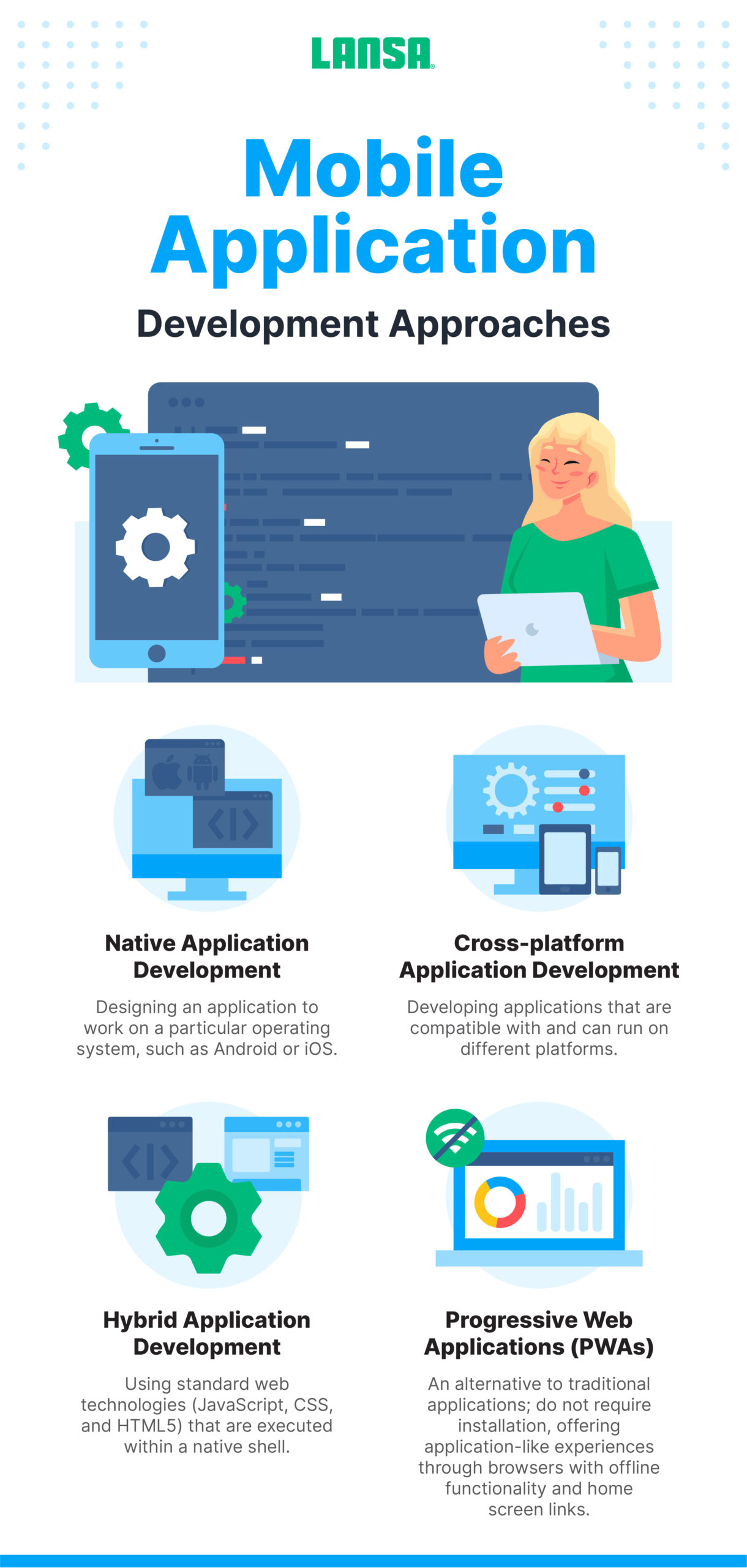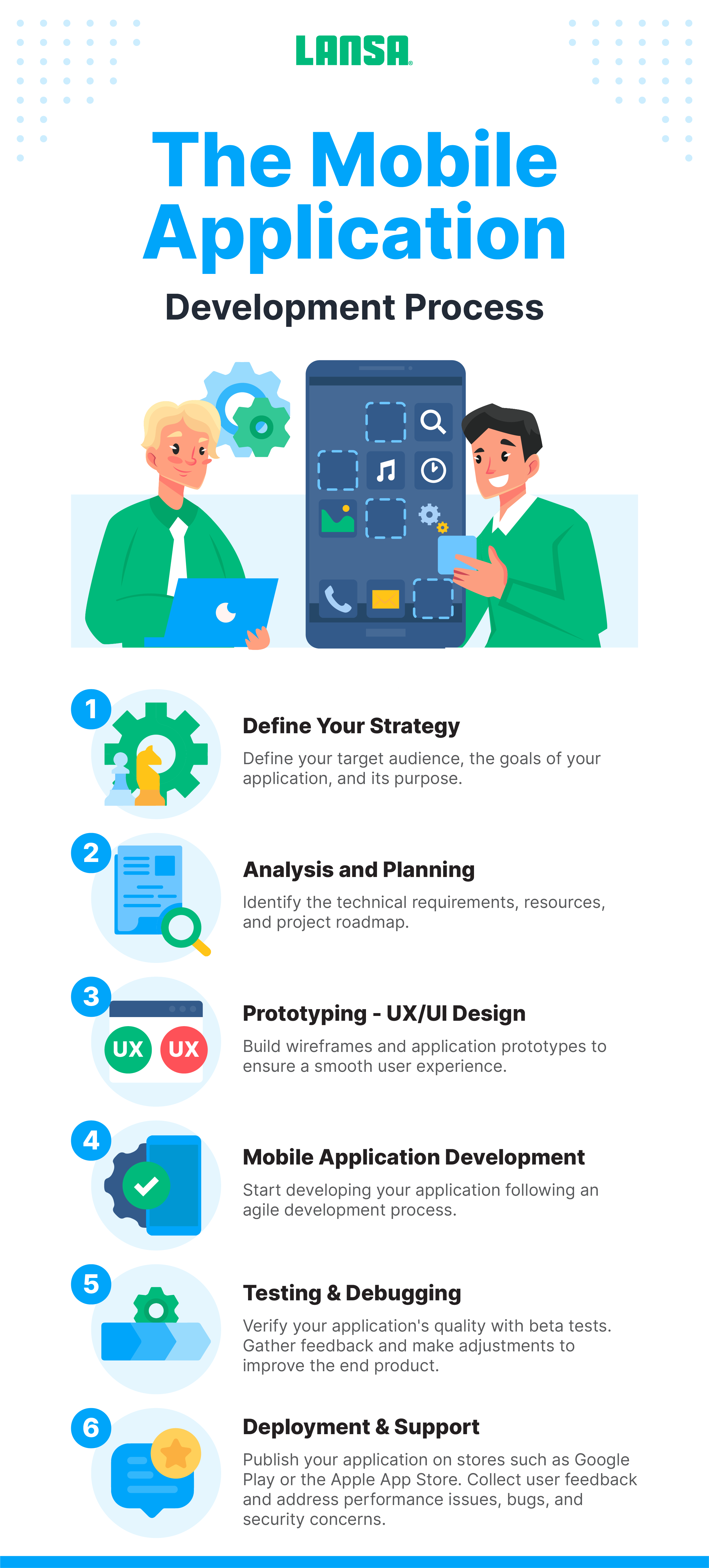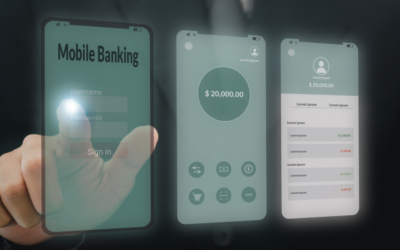Mobile app development works as a bridge between a company’s offering and the tech many customers love to use the most: that which puts usability and pleasure in the palm of their hand [1].
In this guide, we dive into what mobile software development is, ways of approaching it, the different types of mobile apps, and the most effective processes and technologies.
What is Mobile Application Development?
Mobile application development refers to the process of making software applications that operate on a mobile device. Mobile apps typically use a network connection to enable users to use them. Central to the process of creating mobile apps is building software bundles users can install, implementing the appropriate backend services, and testing the app on the different devices it’s designed for.
Currently, the two popular mobile operating systems are Android by Google, which boasts 2.6 million mobile apps [2], and iOS by Apple, which has around 1.6 million apps in its portfolio [3]. When it comes to Apple tablets and smartphones essential applications, such as an internet browser and the Apple App Store are already installed. Similarly, Android devices also come with installed apps and users have the option to install additional applications, from the Google Play Store.
Mobile App Development Approaches

Choosing the right approach depends on the goals of your business or client. Here are the most common approaches in mobile app development and why developers opt for them:
Native App Development
Designing native apps in mobile app development involves writing them using the programming language and frameworks a specific platform, such as iOS or Android, provides. Natively developed apps are then run directly on the target operating system.
With native application development, apps are designed using integrated development environments (IDEs) and made to work on a particular operating system (OS), such as Android, or iOS. It involves using specific languages, as well as development environments and kits, designed for the mobile OS you’re developing for. For instance, you would develop an iOS app separate from one for Android.
Advantages
- Easier to take advantage of the specific features of each device, which optimizes UI for your end users
- App updates are more straightforward
- Tends to be more reliable
- Security features are developed for your target environment
Disadvantages
- Developing the same app multiple times, once for each OS you build for
- Higher costs due to developing for more than one OS
- More effort is needed in the long term to maintain and update the codebase for each OS
Cross-Platform App Development
You can write cross-platform mobile applications in a range of different programming languages and frameworks. However, they get compiled into a native application, running on the operating system of the device.
How do you develop cross-platform mobile applications? In mobile application development, designers typically use tools and frameworks, such as those based on .NET/C# or JavaScript, specifically designed for building cross-platform apps. In this way, if your developers know how to use these tools, they can build solutions for multiple environments.
Advantages
- A uniform experience for end-users, no matter which OS they’re using
- The ability to publish on multiple platforms simultaneously
- Reusable source code
- The ability to reach a wider range of end-users
- Relatively quick time-to-market because you’re developing for all target platforms at once
Disadvantages
- You can only use platform features that both operating systems share, such as Apple’s Airplay function
- You may have to deal with major code rewrites when there’s a mobile OS update
Hybrid App Development
In hybrid mobile app development, developers build apps using web technologies like JavaScript, HTML5, and CSS. The apps are bundled into app installation packages. They’re different from native apps in that they work on what’s called a “web container,” which provides the app’s runtime, as well as a bride for APIs built for native devices.
Advantages
- You can use one development team for all target users and devices
- The code you create is easily portable
- You have a shorter time to market
- It may cost less to develop because you don’t have to write and test code for individual platforms
- Consistent, high-quality user experience regardless of the OS they’re using
Disadvantages
- May run slower because they have to download individual elements from the web
- Might have features that don’t work well on some devices
- Lower performance than native apps
Progressive Web Apps: PWAs
Progressive web apps give users a unique installation experience by skipping the app store delivery process. PWAs incorporate browser capabilities, including working offline, adding links to a device’s home screen, and running background processes.
Advantages
- Uses a single codebase
- Users can access it without having to go to an app store
- Has a mobile-friendly UI
- Is easy for a wide range of users to enjoy on several different operating systems
Disadvantages
- Incompatibility with some older OS’s, such as iOS versions older than 11.3 [4]
- Problems working on some legacy devices, since PWAs are relatively new
- Incompatibility [4] with some device features, including proximity sensors, Bluetooth, and other features many have grown accustomed to
Native Application vs. Hybrid Application
Native and hybrid apps are similar in that your end-users can install them from an app store. In some cases, a hybrid app, thanks to the native shell it runs within, provides a similar experience as a native one for your end users. For instance, a hybrid app can leverage the calendar function in iOS as well as its notification system.
However, the development process for hybrid apps is unique. You can write your code in one codebase, which you can use for multiple operating systems. With native app design, on the other hand, you have to write different code for each OS your end users will use.
Developing hybrid apps may also cost less. This is because developers can code them using common languages, such as HTML5, JavaScript, and CSS, and then integrate them with frameworks designed for hybrid apps, such as React Native or Cordova.
Even though a hybrid app can perform well on multiple operating systems, it can’t take advantage of some of the qualities of specific platforms that may deliver smoother or richer user experiences.
For instance, if your app has a lot of detailed graphics or demands heavy processing, it may be better to go with native app development instead of hybrid.
On the other hand, if your app doesn’t need a lot of resources, using a hybrid approach exposes it to a wider user base across more operating systems.
Native vs. Cross-Platform Mobile App Development
The decision between native and cross-platform app development boils down to your timeline, security requirements, performance needs, and budget.
- Timeline. If you want a faster time-to-market, you may want to opt for cross-platform development because these apps tend to have shorter building timelines. Native development typically takes longer and more effort to maintain, which can extend your time-to-market.
- Security. When developing native apps, you can often take advantage of the target OS’s built-in security tools. Libraries designed for a specific OS often have features like encryption and fraud detection already incorporated.
- Performance. Optimizing performance, especially for compute-heavy apps, may be easier if you use native development. You can focus on the performance features your target OS comes with. This may be more effective than settling for a middle ground—features that work OK in two OSs.
- Budget. With cross-platform development, you may end up spending less because you can use the same code for two different operating systems. This can significantly reduce your development spend, especially when you compare it to the cost of paying two different teams to build two solutions for two native apps.
Developing for both iOS & Android: Which Approach to Choose?
What’s the best software for developing an app for both iOS and Android? One option would be to develop two, separate native applications. You could use native APIs and programming languages specific to each OS. This can result in a powerful app that benefits from OS-specific APIs, which is why most enterprise developers would benefit from this approach.
If you choose to develop native apps one at a time, it may be best to start with Android. Many developers find this convenient because it’s easier to develop a minimum viable product (MVP) and then convert it to iOS.
You could also take the hybrid approach, where you write all of your code for both operating systems at once. Since hybrid apps leverage a single codebase that can work on either platform, this tactic can save a lot of time in the mobile app development process.
However, with hybrid app development, you don’t have access to the OS’s native APIs, so they may work best for simple apps consisting of just a few pages.
One such solution is Visual Lansa; you get an integrated, responsive low-code design environment. You can use it to quickly create a single set of code and then deploy it on both iOS and Android—so you don’t have to choose one over the other.
Learn how you can develop applications for mobile users using Visual LANSA.
Technologies Used in Mobile App Development
By understanding the technologies you can use while developing mobile apps, you put yourself in a better position to create winning experiences for your target users. This is often the first step when exploring how to develop a mobile application. Here are some of the more effective technologies:
- Visual Lansa. With Visual Lansa, a low-code development solution, you can build or modernize IBM I (As/400) apps and then make them available via a web interface [5]. This gives you more options when it comes to the devices users can use to access your app. Both Kawasaki and Baustoff Union have built mobile apps with Visual Lansa [6].
- React Native. This is a JavaScript framework that many use to create cross-platform mobile apps. Some examples of apps built with React Native include Facebook and Airbnb.
- C++. With C++, you can create cross-platform apps. This also makes it easier to reuse your code if you decide to create a different but similar app for another OS.
- PHP. PHP is known for its scalability and flexibility. For instance, PHP makes it easy to add more servers if you need to enhance your app’s performance.
- Flutter. Flutter enables you to see changes in real-time using a feature called Hot-reload. It also features easy-to-understand documentation, compatibility with multiple IDEs, and developer-friendly widgets.
- Swift. Swift is designed for building apps for devices that run iOS, such as Apple computers, mobile devices, and TVs. Developers have built apps for both Uber and Slack using Swift.
- Xamarin. You can use Xamarin to craft apps for both Android and iOS because it uses C#. This also gives Xamarin the flexibility to work well with SDKs specific to Android and iOS, such as the Android SDK and Cocoa Touch.
The Mobile App Development Process

One of the most common pain points of app development mobile involves trying to figure out how to approach the process. Here’s a step-by-step guide to help you set up your development strategy:
Step 1: Define Your Strategy
As you define your strategy, you should consider:
- Your target audience, keeping in mind the kinds of experiences they want
- The goals of your app, such as increasing current customer engagement or connecting with new consumers
- The purpose of your app, including what it needs to do, whether you’ll use it to sell products or services, or what it will accomplish for internal users
Step 2: Analysis and Planning
During the analysis and planning phase, you pinpoint the technical requirements your app will need to enable the required features. You then develop timelines for your project and decide which resources you’ll need, such as designers, testers, money, and programming tools.
Step 3: Prototyping – UX/UI Design
The prototyping process involves building wireframes and app prototypes that make it easier to visualize how the app works. It’s good to bring end-users in at this phase so you can gather feedback regarding how they feel about your prototypes.
Step 4: App Development
App development is where the rubber meets the road. This is when you take the feedback from the prototyping process, as well as the goals and technologies chosen in previous phases, and start writing your code. A low-code development process, such as what Visual Lansa makes possible, often speeds up the development phase without sacrificing quality or functionality.
Step 5: Testing & Debugging
As you test and debug your app, you may want to do so in stages. For example, you could do an alpha test using people in your organization and a relatively small hand-picked group of outsiders. After gathering feedback and making adjustments, you can then proceed to a beta test, which brings in members of the general public.
Step 6: Deployment & Support
Once your app’s ready for the real world, you can move on to deploying it and supporting users. The deployment phase typically involves publishing the app on stores such as Google Play or the Apple App Store. The support process is different for each app, but it tends to involve gathering feedback, making bug fixes, addressing individual user issues, and strengthening security on an ongoing basis.
The Mobile App Development Lifecycle
In mobile app development, you have two complementary elements: the front end and the back end. The front-end is what users interact with on their devices, and the backend consists of the services that support the front-end experience.
Front-end vs. Back-end
Mobile apps have evolved from simply providing information to being highly interconnected mechanisms that rely on external data sources and processes. That’s why a front end that integrates with a back end is necessary. The user interface on the front end needs to get updated with data coming from the back end. For example, an e-commerce app has to pull prices and images from a database hosted on the back end. It then displays this information via the UI in the front end.
How Do the Front and Back Ends communicate?
The front end and back end often communicate using application programming interfaces (APIs). In some cases, a third party makes the API available to the developer via an agreement. The developer can then use the API to enable the front and back ends to exchange data.
For example, you can present location information to your users by incorporating the Google Maps API.
Developers can also build their own APIs and use them to have the front-end call information from the backend.
The Role of a Cloud-Based Back End
By using a cloud services provider, a developer can offload much of the work involved in developing and maintaining their app’s backend infrastructure. If the developer wants to scale the app up, for example, they can just let the cloud backend service provider know and then get back to working on user-facing features.
By using a back-end-as-a-service provider, a developer also doesn’t have to worry about implementing and maintaining security solutions to protect their backend resources from cyber attacks.
The Front-end Development Workflow
Building the front end involves combining multiple disciplines and skills to create a cohesive end product. You or a graphic design expert may handle your visual elements, including icons, colors, and themes.
You also have to focus on the usability of the user interface, making sure individual components work well together. The user interface design process also involves making sure the end-user has a logical, straightforward, and comfortable experience.
At times, you may have to bring in experts to ensure the user experience lives up to specific expectations. For example, when designing a sports game, consultants and motion graphics developers may collaborate to deliver life-like kicking, jump shooting, passing, dribbling, and more.
How Mobile Apps Integrate with the Backend
An important facet of the development process is building the logic that makes network calls to your app’s backend services, retrieve’s data, and updates data in the back end using information the app generates.
The backend services developers use are often accessed through application programming interfaces (APIs), such as GraphQL and REST.
It’s often best to bring in a third party when building out your mobile app back end. This saves you the time of having to code backend components yourself or dig through libraries to find the right components. In many cases, your back-end components are similar to those of existing apps, and a cloud service provider may already have the elements, such as databases, you need.
Interaction with the Backendbackend Data
The front end in mobile application development uses information and services that exist in the backend. A backend database is a good example. Mobile developers incorporate protocols in their code that access the target database, credentials needed to authenticate and authorize access, and the commands needed to get the data the front end needs.
REST APIs are often used to interact with data sourced from the cloud, such as a cloud-hosted database. Developers also use GraphQL, which provides support for querying using a single API endpoint. GraphQL also gives developers a data scheme they can use to build and extend the data models that make up their apps.
Future Trends in Mobile Application Development
Like all technologies that stand the test of time, mobile app development is changing. By staying abreast of the following developments, you can remain on the cutting edge of mobile app development and the tech that drives it.
Integrating Emerging Technologies (AR, VR, 5G, AI, Wearables)
By integrating emerging technologies, you can meet the needs of a greater number of customers, primarily because they may have come to expect certain functionality from an app like yours.
For example:
- Augmented reality (AR) and virtual reality (VR) provide more immersive experiences that many people find more rewarding than simply interacting with words on a screen
- 5G paves the way for greater connectivity and faster connections, both of which enable better real-time experiences for users
- AI can make it easier to customize the app’s features to what your users need, as well as collect and analyze user behavior data
- Wearables help interweave your app in your users’ daily lives, keeping your business within reach all day long
Low-Code Development
Low-code mobile app development makes the development process faster and simpler by giving you pre-designed tools. Instead of having to manually code in features or rummage through extensive libraries, you can use a low-code environment to produce apps with less effort and in a fraction of the time.
Security
By focusing on security, app development has a brighter, safer future, especially considering the increasing number of online threats. Security in the context of mobile app development focuses on keeping cloud services and servers safe from attackers, as well as avoiding vulnerabilities that can give attackers a foothold.
Key Takeaways
Designing mobile apps that enable business growth comes down to:
- Choosing the right approach, such as hybrid, native, progressive, or cross-platform, according to your performance and feature needs
- Designing a systematic development lifecycle that continually gathers user data as time passes
- Leveraging the most efficient and easy-to-use design tools, such as low-code environments
- Keeping up with future trends in mobile app development, such as AR, VR, 5G, AI, and low-code
With Visual Lansa, you can code faster while building an endless range of apps. Visual Lansa enables you to create progressive web apps that have the feel and function of native apps, creating rewarding experiences for end-users. Contact us to learn more today.
Frequently Asked Questions
What is the intent of mobile app development?
In the context of mobile app development, “intent” refers to an object that requests an action from another component in the app. For example, it may request to pass data from a database to a field the user interacts with.
Can one app work on all devices?
One app can work on all devices that support a specific browser if the app is made available through a web portal.
How long does it take to develop a mobile app?
The development process varies considerably based on the complexity and testing needs of an app, but using low-code tools cuts down on how long it takes.
How much does it cost to develop a mobile app?
The cost to develop an app varies based on how much you have to pay developers according to the time they invest in building it. In some cases, you can get an app built for a set fee, and in other situations, you may have to pay a team by the hour.
How often should I update my mobile app?
Typically, the frequency with which you update a mobile app depends on feedback from users and app performance. For instance, if users report several bugs or usability issues throughout the year, you may end up updating your app five or six times. Also, if a security vulnerability arises, you’ll want to address it right away, which could require another few updates over the course of a year.
References
[1] Al-Shamaileh, O., & Sutcliffe, A. (2023, February 1). Why people choose Apps: An evaluation of the ecology and user experience of mobile applications. International Journal of Human-Computer Studies. https://doi.org/10.1016/j.ijhcs.2022.102965
[2] Topic: Google Play Store. (2023, November 6). Statista. https://www.statista.com/topics/9929/google-play-store/#topicOverview
[3] Biggest app stores in the world 2022 | Statista. (2023, August 29). Statista. https://www.statista.com/statistics/276623/number-of-apps-available-in-leading-app-stores/
[4] Progressive Web Apps: Advantages and Disadvantages [2023]. (n.d.). https://brainhub.eu/library/progressive-web-apps-advantages-disadvantages#progressive-web-apps-disadvantages
[5] YouTube. (n.d.). https://www.youtube.com/embed/rhH-2LgTEO0?wmode=opaque&rel=0
[6] LongRange Case Studies. (n.d.). https://www.longrangemobile.com/casestudies/






0 Comments